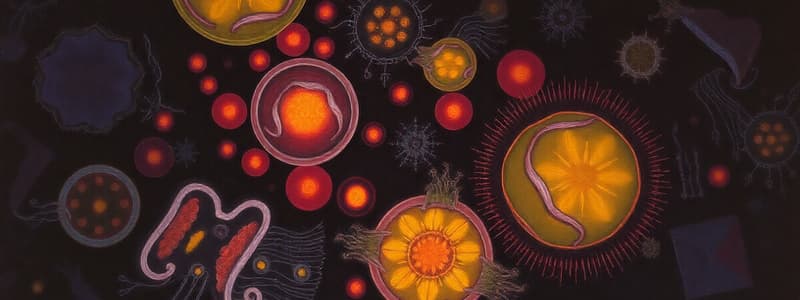Podcast
Questions and Answers
What type of cytoskeletal fiber is most involved in helping a cell change shape?
What type of cytoskeletal fiber is most involved in helping a cell change shape?
- Tubulin fibers
- Microfilaments (correct)
- Microtubules
- Intermediate fibers
What structure surrounds the nucleus of a cell?
What structure surrounds the nucleus of a cell?
- Nuclear envelope (correct)
- Ribosome
- Nucleolus
- Nuclear wall
Which organelle is primarily responsible for synthesizing proteins in the cell?
Which organelle is primarily responsible for synthesizing proteins in the cell?
- Ribosomes (correct)
- Endoplasmic reticulum
- Nucleus
- Mitochondria
Which organelle is involved in modifying, sorting, and packaging proteins?
Which organelle is involved in modifying, sorting, and packaging proteins?
Which of the following is true about both chloroplasts and mitochondria?
Which of the following is true about both chloroplasts and mitochondria?
In which part of the cell are bound ribosomes primarily located?
In which part of the cell are bound ribosomes primarily located?
What is the function of mitochondria in a cell?
What is the function of mitochondria in a cell?
What type of cells contain a cell wall?
What type of cells contain a cell wall?
Which level of organization does the small intestine represent?
Which level of organization does the small intestine represent?
Which of the following statements about colonial organisms is accurate?
Which of the following statements about colonial organisms is accurate?
Which type of molecule forms the cell membrane?
Which type of molecule forms the cell membrane?
What characterizes phospholipids?
What characterizes phospholipids?
What does diffusion involve?
What does diffusion involve?
The dispersal of ink in a beaker of water exemplifies which process?
The dispersal of ink in a beaker of water exemplifies which process?
How do proteins assist substances in crossing the lipid bilayer?
How do proteins assist substances in crossing the lipid bilayer?
How do sugar molecules cross the cell membrane?
How do sugar molecules cross the cell membrane?
Which process does not require energy?
Which process does not require energy?
How do ions typically move through ion channels?
How do ions typically move through ion channels?
What is the term for water's movement into or out of a cell?
What is the term for water's movement into or out of a cell?
What type of transport is osmosis categorized under?
What type of transport is osmosis categorized under?
Flashcards are hidden until you start studying
Study Notes
Cytoskeleton
- Microfilaments, microtubules, and intermediate fibers are the three types of protein fibers that make up the cytoskeleton.
- Microfilaments help cells change shape.
DNA and Proteins
- DNA and proteins are both made in the nucleus.
- Ribosomes are involved in protein synthesis.
Nucleus
- The nuclear envelope is a double membrane that surrounds the nucleus.
- Proteins are made on ribosomes.
Organelles
- Bound ribosomes are attached to the membranes of another organelle.
- The endoplasmic reticulum moves proteins and other substances through the cell.
- The Golgi apparatus modifies, sorts, and packages proteins.
- Mitochondria are associated with energy production in the cell.
- Chloroplasts are organelles found in plant cells that are responsible for photosynthesis.
- Chloroplasts and mitochondria both produce ATP.
Cell Types
- All plant and animal cells contain a cell membrane, mitochondria, and endoplasmic reticulum.
- Plant cells have a cell wall, unlike animal cells.
- Prokaryotes are unicellular organisms that lack a nucleus and other membrane-bound organelles.
- Bacteria are examples of prokaryotic cells.
- The small intestine is an organ.
Colonial Organisms
- Colonial organisms are a collection of cells that are capable of surviving independently.
Cell Membrane
- The cell membrane is made up of phospholipids.
- Phospholipid molecules have one polar phosphate head and two nonpolar fatty acid tails.
Diffusion
- Diffusion is the movement of a substance from an area of high concentration to an area of low concentration.
- Diffusion can occur through a lipid bilayer membrane, as well as in liquids.
- The dispersal of ink in water is an example of diffusion.
- Channel proteins act as tunnels for specific substances through the cell membrane.
Active Transport vs. Passive Transport
- Active transport requires energy, while passive transport does not.
- Sugars cross the cell membrane through facilitated diffusion.
- Ion channels are involved in the passive transport of ions.
- The sodium-potassium pump requires energy.
- Osmosis is the diffusion of water across a semipermeable membrane.
Osmosis
- Osmosis is a type of passive transport.
- Water passes through the cell membrane through channel proteins specifically for water, and directly through the lipid bilayer.
Studying That Suits You
Use AI to generate personalized quizzes and flashcards to suit your learning preferences.




